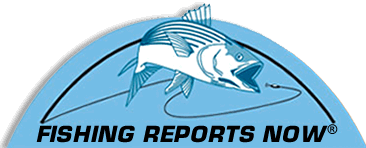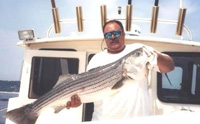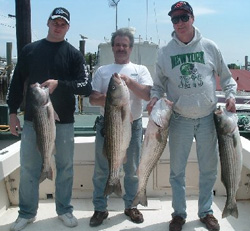The Main Event |
||
|
Life. The more you get in life, the more you want. No matter whether it’s money, possessions or something more valuable So you’ve got a few fishing trips under your belt this year. At first this spring, being outdoors and throwing a line was enough. Felt great after winter, even if the lingering chill kept fish from biting. Then you actually wanted to catch something. If you fished on Raritan Bay, maybe you bagged a 2-pound winter flounder first. Then a 6-pound, schoolie striped bass. Next an 8-pound bluefish. That’s about the progression of springtime catches on the bay. But that isn’t the end. Not at all. What’s next? More striped bass. Coming … this way. Soon. The main event in spring. Are you ready to rumble? Capt. Kyle Tobias from Evening Tide Charters, Laurence Harbor, looks forward to this fishing like no other trips during the year. The spring run of migrating striped bass on Raritan Bay offers the best chances of grabbing the year’s largest striped bass for him and his charters. Specifically, fishing with livelined bunker on the bay fools his largest stripers of the year at that time. |
|
Bunker migrate to the bay in spring, arriving from down south through the ocean to spawn, just like stripers do. Bunker swim the bay from spring through fall, but the schools are thick in spring and thin out somewhat in summer, when some move to cooler water in the ocean. Kyle and crew on Evening Tide’s springtime, livelining trips will typically head out early in the mornings to catch bunker for bait before sunup, when the schools are “tightened” the most, before boat traffic scatters Charters join a trip from the very beginning, when the bait will be caught, and enjoy the chance to experience the whole process. Kyle usually runs to favorite spots to find plenty of the menhaden, places including the channels at the back of the bay or the Arthur Kill. Other places that bunker commonly school in the mornings include off Keyport and at Great Kills Harbor. But the bait can be found throughout the bay. The crew will castnet the baitfish and will sometimes also snag them with weighted, treble snagging hooks, dropping the fish in the livewell to keep them alive all day. Once a sufficient amount of bait is caught, fishing might begin right in the schools of bunker that were being caught for bait.
One of the best things about this method, or flat-lining, is that sometimes stripers will come up and crash the menhaden right on the surface, an exciting, visual strike. But stripers often swim deeper, commonly along the bottom. If flat-lining doesn’t work, the bait might be fished somewhat deeper with a weight on a fish-finder or sinker-slide rig to sink it farther in the water column. If Kyle wants to drop the bait even farther, all the way to the bottom, he’ll use a weight on a three-way swivel, not a sinker-slide, because the bunker on a sinker-slide will often swim upward, pulling the line through the slide. Kyle will use a 30- to 60-pound leader, choosing a light one if waters are clear, and vice versa. Heavy leaders will be used if toothy bluefish infest the waters and might bite through the leader. With livelining especially, the lighter the line, the better, because a lighter line allows the most natural presentation. Fluorocarbon leaders are used if the water is very clear, but that’s rare in Raritan Bay, and the bay is often stained or discolored enough to make fluorocarbon unnecessary. If chunks of the bunker are fished instead of live bunker, the rigs are the same. Kyle might fish chunks if livelining draws no strikes. Then the boat is often anchored, and hooked chunks are tossed overboard, and the crew chums with small pieces of bunker and ground bunker placed in chum pots and dropped to the bottom. The point is to attract stripers, draw them in, from the smell of the chunks and chumming. But sometimes chunks are drifted through the schools to search for a hook-up. If fish are hooked on chunks, live bunker will be fished again, because live ones usually attract the biggest bass. But usually the crew is chasing bunker schools to find the stripers. A school is usually found visually by searching for bunker flipping and splashing on the surface, maybe with telltale birds working above. If a school is found on the surface, and they often are, it's usually a safe bet that stripers or blues are underneath them, feeding on them, pushing them toward the surface.
The blues tend to feed right in among the bunker. But the stripers are often hanging on the bottom and behind the schools. The ideal way to approach a school is with stealth and sneakiness to avoid scattering and scaring the fish away. Motoring ahead of the school, cutting the engine and drifting into the fish is best. Running up behind the school doesn’t work, because the fish just school farther away. The drift is begun, and the angler tosses the live bait into the water and feeds out line, allowing the baitfish to do its thing. Maybe 75 or 100 feet of line is paid out before the line is reeled back in, and the process is started all over again. Sometimes the live bunker has a mind of its own and wants to stay close to the boat. Other times it makes a beeline away from the vessel. Chunking can be done the same way, whether anchored or drifting, or a chunk can be dropped with a weight right down to the bottom if anchored. The live baits are fished in free spool with as little drag or tension as possible. If the rods are left in the rod holders, the clicker is engaged to hear a run-off. If the rods are held, the clicker is turned off, because the angler will feel the run-off. To set the hook when a fish bites, if the angler is flat-lining, the angler will quickly point the rod at the fish, engage the drag, and when the line comes tight, lift up to set. If weight is used on a sinker slide, the same method is employed, because the line will slip through the slide, with no tension. If weight is used on a three-way, and no line can slip through, the weight will often hook the fish itself. Kyle prefers 20-pound class rods about 6 ½ feet long. He likes baitcasting reels with lever drags instead of star drags, so the amount of drag is easily adjusted while the bait is fed out on the line, but the lever can be instantly thrown into engagement for the hook-up. A little heavier rod is used with livelining than with chunking. With livelining, no weight is often used, so some backbone is handy for setting the hook. With chunking, weight is often used, so the fish will hook itself, and backbone is less important. Kyle will search to find whether a school holds any stripers. Sometimes no fish, neither blues nor stripers, swim around the bunker. Sometimes a school will only hold blues. Kyle keeps an eye on the fish finder and looks for telltale marks of bigger fish behind the schools. Those are stripers. Sometimes no schools will appear on the surface, and then Kyle will look for them under the surface on the fish finder. Many different spots in the bay attract bunker schools and striped bass. The edges of channels including Reach Channel are popular. So are different rock piles in the bay. Sometimes the fish stage toward the back of the bay near the rivers until they’re ready to push up the rivers to spawn. Spots along the mouth of the bay, like Romer Shoal and Flynn’s Knoll, can hold the fish at the beginning of the run, as the fish arrive from the ocean and the south, and at the end of the run, as the fish depart to the ocean and swim north. Sometimes no schools will be found, and then Kyle searches for stripers at structure, holes, along channel edges and such typical spots that attract fish. If boat traffic breaks up the schools, Kyle will try chunking deep down, because stripers might still be lingering. Early and late in the day is often the best time for the fishing, simply to avoid boat traffic that disperses the schools. The fishing can start from sometime in March to the end of April but usually really kicks in beginning in May, and can last through June, or even into July. The migrators can begin appearing when water temperatures reach the low to mid 50s. When waters reach the low to mid 60s, the larger fish start moving out. Funny how spring fishing can dish out increasingly better catches. The 2-pound flounder. Then the 6-pound, schoolie striper. Next the 8-pound blue. Then how about a 30-pound linesider? Not a bad climax. The more you get, the more you want, though life doesn’t always work out that way. You don’t always get more. But like life, in fishing, if you make the honest effort, take good advantage when the opportunities come up, it’ll work out. Here’s your spring fishing chance. The main event. The migration of big striped bass. Livelining bunker is your best opportunity to take advantage. Get on it. |
||



 When livelining the bunker, a live-bait hook tied on a leader that's attached to the line with a swivel is a simple and favorite rig. There’s no weight attached, and the baitfish is merely dropped in the water and allowed to swim away, and the angler feeds out line.
When livelining the bunker, a live-bait hook tied on a leader that's attached to the line with a swivel is a simple and favorite rig. There’s no weight attached, and the baitfish is merely dropped in the water and allowed to swim away, and the angler feeds out line. Bluefish are always a possible by-catch on these trips and are abundant in spring.
Bluefish are always a possible by-catch on these trips and are abundant in spring.